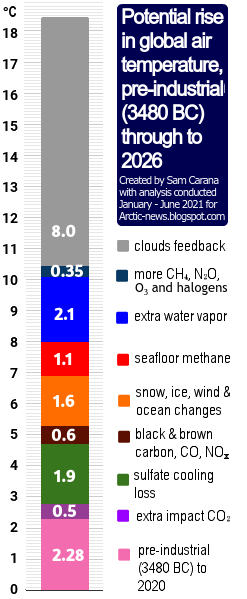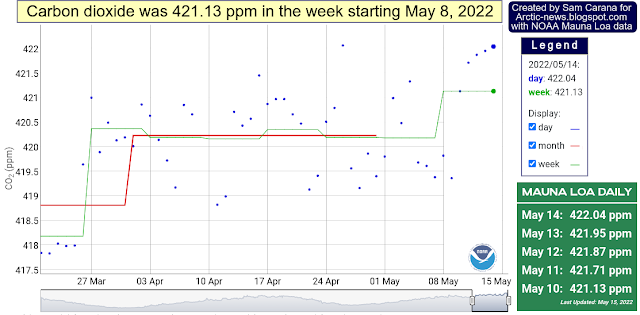The image below was created November 27, 2011, and was part of a poster displayed at AGU 2011, warning about temperatures in the Arctic rising much faster than elsewhere in the world. A trend added on the image shows temperatures approaching 10°C in the 2030s on the background of NASA anomalies versus 1951-1980 in the Arctic.
An updated version of the image was added in March 2012, with the added trend showing temperatures exceeding 10°C above 1951-1980.
Politicians have ignored these warnings for more than a decade and, in some respects, the warnings may even have been too conservative; the above image may have given the impression that such a global temperature rise would be at least decades away, enough for mitigating action to be taken.
An image from a 2016 post warned that a huge rise could take place within a decade, i.e. a temperature rise from 1900 of more than 10°C by 2026.
The above image and further content of the post was also used to create the Extinction Page.
The image below, from a January 2024 post, shows a number of potential temperature trends.
Here are ten critical issues that could trigger a huge global temperature rise as early as 2026.
2. Ocean heat
The image below shows a trend (based on 1880-2020 data) for sea surface temperature anomalies (versus the 20th century average) on the Northern Hemisphere. Note that the image indicates that the latent heat tipping point was crossed in the year 2020.
Keep in mind that the above image shows sea surface temperature anomalies, which are suppressed during a La Niña period. We're currently in the depth of a persistent La Niña. Underneath the sea surface, though, temperatures are rising fast which could be even more critical than the temperature rise at the surface, the more so since a freshwater lid appears to be forming at the ocean surface that enables hot water to dive underneath this lid and underneath the sea ice, and enter the Arctic Ocean.
As the image below shows, the world ocean, in 2021, was the hottest ever recorded by humans (Lijing Cheng et al., 2022).
As temperature in the Arctic rises, the Jet Stream changes, resulting in more extreme weather and enabling cold air to leave the Arctic and warmer air to enter the Arctic. This, in combination with the freshwater lid on top of the North Atlantic, can cause ocean heat to build up in the Atlantic Ocean, to suddenly be pushed along the path of the Gulf Stream at high speed into the Arctic Ocean, as discussed in an earlier post.
The image on the right shows a trend based on PIOMAS data. The trend points at zero Arctic sea ice volume by September 2027. Note that the volume data in the image are averages for the month September — the minimum for each year is even lower.
Carbon dioxide levels are even higher over the Arctic. Very high carbon dioxide levels were recorded recently at Barrow, Alaska.
Between 14 and 15 million years ago, the temperature in central Europe was 20°C higher than today, as illustrated by the image below (adapted from a 2020 study by Methner et al.).
It is ominous that such high anomalies show up in the Arctic during a La Niña period and during Winter on the Northern Hemisphere, when only very little sunlight is reaching the Arctic.
 |
| [ from the Extinction page ] |
9. Loss of aerosol masking effect, rise of black carbon
A further rise in temperature to rise looks set to unfold due to the falling away of sulfate aerosols, while there could be a further temperature rise due to releases of other aerosols that have a net warming impact, such as black and brown carbon, which can increase dramatically as more wood burning and forest fires take place.
10. Clouds feedback
As the temperature keeps rising, this will trigger further self-reinforcing feedbacks such as an increase in water vapor combined with a decrease in lower clouds decks, further increasing the temperature, as described at the clouds feedback page.
Joint impact
There are further tipping points and, importantly, there can be a lot of interaction between them. An earlier post mentions the collapse of biosystems and loss of carbon sinks.
Altogether, the temperature rise by 2026 could be more than 18°C compared to pre-industrial, as illustrated by the image on the right from the Extinction page.
Conclusion
The situation is dire and calls for comprehensive and effective action, as discussed in the Climate Plan.
• Latent heat
https://arctic-news.blogspot.com/p/latent-heat.html
• Carbon dioxide reaches another record high
• Albedo and more
https://arctic-news.blogspot.com/p/clouds-feedback.html
• Arctic Hit By Ten Tipping Points





















